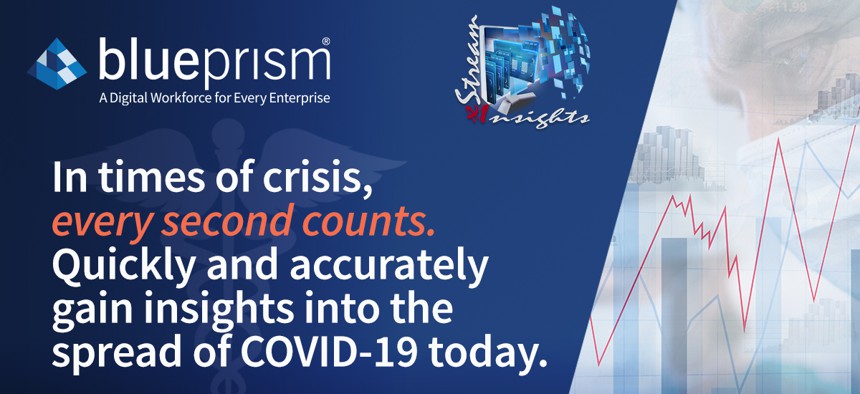sponsor content What's this?
RPA and Data Analytics for Comprehensive Situational Awareness

Presented by
Blue Prism & IBI

By Deep Uppal, Vice President, Public Sector Technology Innovation, IBI and LC Cook, VP Public Sector Sales and Alliances
Crisis always leads to disruption. Unavailable essential supplies, conflicts in spending priorities for critical projects, disruptions to supply chains, and reduced availability of essential employees create a rough sea for all boats. There will be wrecks, and every state and municipality needs to prepare for them. Data, analytics and RPA software combined in a single solution allow you to have greater situational awareness preparedness. This software combination reduces the effort spent on analyzing ongoing emergencies, distributes correct information, and prioritizes the most crucial resources for any agency: its employees and citizens.
Understanding publicly available data reduces the effort for strategic understanding of situational threats and the necessary course of action to mitigate and/or respond. Organizing analytics across the genres of health, thermal, natural disasters, weather emergencies, and public sentiment provides an opportunity to have a 360 degree view of a situation, analyze, predict, and take confident action. Leadership can source, analyze, and leverage data to avert past mistakes and duplicate prior successes.
RPA’s ability to replace highly transactional and repetitive work frees agency employees and first responders to focus on strategic responses to situations. Utilizing data, analytics, and RPA to automating repetitive tasks benefits government agencies by improving their operations, helping them more easily meet compliance standards, reducing costs, and improving service to the citizen – no matter the situation.
Situational awareness determined the extent, scope, and potential scope of the health effects on the affected populations. Surveillance—the systematic collection, analysis, and interpretation of death, injury, and illness data—enables first responders, government agencies, and public health to identify, prepare for, and respond to adverse health effects (such as COVID-19) in your community.
Health surveillance helps you identify risk factors, track disease trends, determine action items, and target interventions. When you can assess the human health impacts of pandemics and other health emergencies, you can enhance planning, improve response, and mitigate effects.
But for epidemiologists, health care providers, and state governments, tracking and investigating infectious disease is time consuming and inefficient. Systems are backlogged, and response times are slow. And data that’s not submitted in the Fed’s preferred format puts funding at risk.
This is where modern data analysis, robotics process automation (RPA) come in:
- Modern data analysis allows you to assess the human health impacts in real time, evaluate potential problems, and get proactive about planning and prevention.
- RPA digital workers speed the collection and ingestion of the varied data sources necessary for data analysis.
- Digital workers streamline manual, repetitive, error-prone process, quickly improving purchasing efficiency—decreasing response time and help first responders use the right equipment to mitigate viral spread.
- Analytics presents graphic, visual information of personnel and equipment availability, deploying assets to better serve citizens where and when they’re most needed
RPA and modern data/analytics platforms help ensure extensible, proactive responses to any situation. When Intelligence Community (IC) professionals have situational awareness of the environments they’re tasked to understand, they can comprehend the impacts of changes to those environments and even project possible outcomes for improved decision making. They can quickly deploy resources to respond and predict the impact of decisions to help ensure the right decisions are made in a timely manner.
The first case of COVID-19 was reported in China on December 31, 2019. On January 20, 2020, the U.S. had its first reported case. It wasn’t until April we began to see consistent reporting on tests, cases, and deaths. And it took even longer before we began to understand the impacts on our local communities.
Much of the data necessary for emergency preparedness was publicly available ahead of this crisis, but state and local government agencies went without the technology to monitor the threat.
Situational awareness in the context of COVID-19 might involve the following types of data integrated into a modern data analytics platform, fueled by RPA:
- Vulnerable population data: Reveals the number of people most at-risk geographically
- Notifiable Diseases Surveillance System: Provides geographical tracking of infectious diseases in the U.S.
- Hospital capacity data: Illustrates geo-based numbers of available hospital beds at any given time
- Supply chain: Clarifies the connection between commercial transportation and supply chain using a socio-technical network that identifies, targets, and fulfills demand. This information enables the process of deciding what, when, and how much should move, and to where[VG8] . Improving contract invoicing and processing time, as these sorts of repetitive tasks can be fully automated
Integrating publicly available data sets allows for a single view of potential pandemics and other health risks. And the methodology is the same for just about any governmental issue, including:
- Monitoring terrorism, violence, and activism
- Detecting thermal and atmospheric anomalies
- Enabling natural disaster and real-time meteorological alerts
- Monitoring global transportation networks,
- Analyzing global trends and sentiments
- Tracking enterprise-specific threats
Situational Awareness from xStream Insights—powered by Information Builders, Inc. (ibi) and Blue Prism—helps government agencies create more informed preparedness plans. This extensible situational awareness data, analytics, RPA platform gives emergency managers the tools they need to be proactive and stay ahead of the proverbial curve.
See it in action here.





